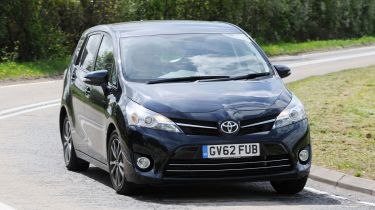Toyota Verso 2.0 D-4D Icon
The new Toyota Verso is practical and economical
A recent update left the Verso’s seat layout untouched, but that’s a good thing, because the folding and sliding mechanisms are very easy to use. The 2.0-litre diesel has a good mix of performance and economy, too, although the Carens does a similar job for less money.
A recent update has given the Toyota Verso a sharper look that’s similar to the latest Auris, and the seven-seater is all the better for it. The pointed nose makes it distinctive from the front, while the creases in the bodywork that kick up in to the rear quarterlights are a neat touch. Overall the upright shape is boxy, but it’s more distinctive than the Kia.
Inside, the dials sit on top and in the middle of the dash, but they’re still within your line of sight, and you soon get used to glancing to the left to look at them.
The centre console is mounted well forward, too, so the gearlever is easy to reach and the big buttons of the standard-fit multimedia system are simple to find. It’s certainly a lot easier to navigate than the C-MAX’s confusing array of buttons.
There’s plenty of space up front, and the same can be said of the back seats. As with the Carens, the three middle-row seats recline, slide and fold individually. It’s just a pity the plastic levers that operate them feel so flimsy.
Used - available now

2023 Kia
Niro EV
19,909 milesAutomaticElectric
Cash £18,600
2021 Ford
Focus Estate
58,077 milesManualPetrol1.0L
Cash £11,700
2024 BMW
M135i
31,851 milesAutomaticPetrol2.0L
Cash £24,500
2021 Mercedes
A-Class
35,083 milesAutomaticPetrol1.3L
Cash £18,400The rearmost seats use pull cords as in the other cars here, but the seatbacks of the row ahead can get in the way if they are set all the way back. Once in place, the Verso’s final row is slightly roomier than the Carens’, although again they’re only really suitable for children. The small back windows mean there’s not much of a view out, either.
As in the Kia, you get plenty of practical touches inside. There’s a twin glovebox up front and storage behind the gearlever, while you can find seatback trays and underfloor storage in the middle row. The doors all have cup-holders, and there’s a pair in the boot for when you’re using the rearmost seats.
The middle row folds in one go, and leaves a completely flat load space. Plus, like the Carens, there’s a storage slot under the boot floor to store the removable load cover when it’s not in use.
On the road, the Verso’s 2.0-litre diesel feels a lot more responsive than the Kia’s 1.7-litre. As a result, the Toyota was a full second faster than the Carens from 0-60mph, taking 11.0 seconds, even in the wet. In-gear response was equally rapid.
Progress is fairly comfortable, but the car suffers from the same unsettled ride as the Carens over rough surfaces. The gearshift is light and the steering vague, so unlike the Grand C-MAX, the Toyota isn’t a car you would want to drive enthusiastically. However, it’s impressively relaxing on the motorway.
At £21,445, the Verso is the most expensive choice, although standard kit is on par with the Kia’s, while the multimedia system is a great addition. This D-4D Icon is also in a higher company car tax bracket than the other two, although these costs are partly offset by the fact that it was the most economical car of the three.
But is that efficient engine enough to give the Verso an edge over its rivals here?







